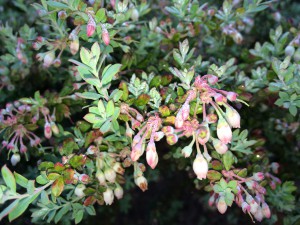
A blueberry bush as a landscape shrub?
Yes! Darrow’s blueberry, Vaccinium darrowii, is closely related to the other blueberries you know and love, but this little gem of a shrub is highly ornamental and will fit in with any landscape scheme.
This compact shrub stays usually stays under three feet tall and wide, making it a perfect size for the home landscape. The small evergreen leaves emerge with a delightful pinkish tinge. In spring, pinkish white small flowers emerge and are followed by small but delicious blueberries. This blueberry will self-pollinate and set fruit, but studies have shown that there will be a sizable increase in fruit set if another variety of blueberry is close by for cross-pollination.
Darrow’s blueberry is a Florida native so it is perfectly adapted to our environmental conditions. Once established it has a moderate drought tolerance. Like other blueberries, it likes full sun, requires acidic soils with a pH between 4.0 and 5.5, and prefers the addition of organic matter into the planting bed if the soil is quite sandy. Pests are usually not a problem except for competition for the ripe fruit from wildlife.
If needed, there are several fertilizer options for blueberry; a 12-4-8 with 2% magnesium, a “blueberry special” formulation or a fertilizer formulated for camellias and azaleas. Whichever you use, apply the fertilizer lightly and widely spread around the plant– only about one ounce per plant every 2 months during the growing season April through October. Blueberries can be easily killed by too much fertilizer.
For more information, please see:
Gardening Solutions: Blueberries
Florida Native Plant Society: Darrow’s Blueberry
 0
0
